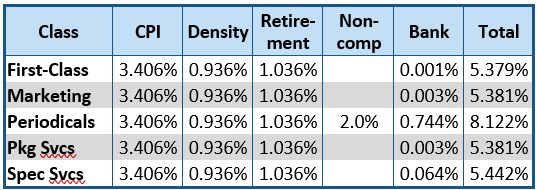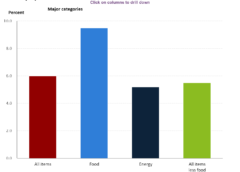The Bureau of Labor Statistics March 14 release of the Consumer Price Index for February supplied the final figure needed to calculate the CPI-based portion of the pricing authority that will be available to the Postal Service for its anticipated April filing: 3.406%.
Part one
The agency’s CPI-based rate authority resets to zero after every price filing, so the size of that authority for a subsequent filing is directly driven by how fast inflation pushes up the monthly CPI. Calculation of the Postal Service’s CPI-based rate authority uses one of three different formulae: for an increase filed twelve months after a previous filing, or for an increase filed at a longer or shorter interval.
The “annualized” CPI figure is calculated over a rolling twelve-month period and reflects the pricing authority that would be available to the USPS if it were to file a rate change at that point, twelve months after an earlier filing. Currently, as the USPS has sought price increases every six months, its rate authority still resets after each filing, but the formula for a less-than-twelve-month cycle is used. As with the “annualized” figure, that can be calculated monthly to track growth in the net pricing authority available at any point. In this case, after six months, the USPS accrued 3.406% of pricing authority since its filing in October 2022.

Parts two and three
However, the CPI-based authority is supplemented by “adders” provided by the Postal Regulatory Commission in November 2020, as well as any “banked” authority that was left over after the preceding price increase.
The “density” adder is related to the loss of volume per delivery stop. The “retirement” adder funds the Postal Service’s amortization of its remaining retirement system (CSRS and FERS) liabilities; (last year’s Postal Service Reform Act removed the requirement to pre-fund future retiree health costs). The “non-compensatory” adder is for a mail class that’s not covering its costs, and must be used either completely or partially in the first rate-filing after the PRC’s Annual Compliance Determination is issued (which it must be by the end of March). It does not have to be used in other price filings that year and can be “banked.”
Upcoming Webinar
The Postal Rate Case
April 18, 2023 – 1:00 PM ET
The “density” and “retirement” adders, calculated by the USPS after the end of each fiscal year and validated by the PRC, can only be used once annually. For 2023, the “density” adder is 0.936% and the “retirement” adder is 1.036%. The “non-compensatory” adder is a fixed 2%. (It currently would apply only to the Periodicals class.)
The Postal Service’s “banked” authority is the difference between the authority it had for a preceding filing and what it actually used. The USPS typically leaves a small percentage of rate authority in its “bank.”

How the costs driving the “density” adder are calculated was the subject of a dispute between the USPS and a coalition of mailer groups on which the PRC recently ruled (see page 3), rejecting the mailers’ position that could have zeroed out the adder. Resolving the adder was necessary as it’s a factor in the PRC’s ACD calculations – and, in turn, those defining the Postal Service’s April filing. What the USPS actually will seek will be revealed in its upcoming filing, expected by no later than April 10, with the higher prices likely to be implemented in mid-July.


